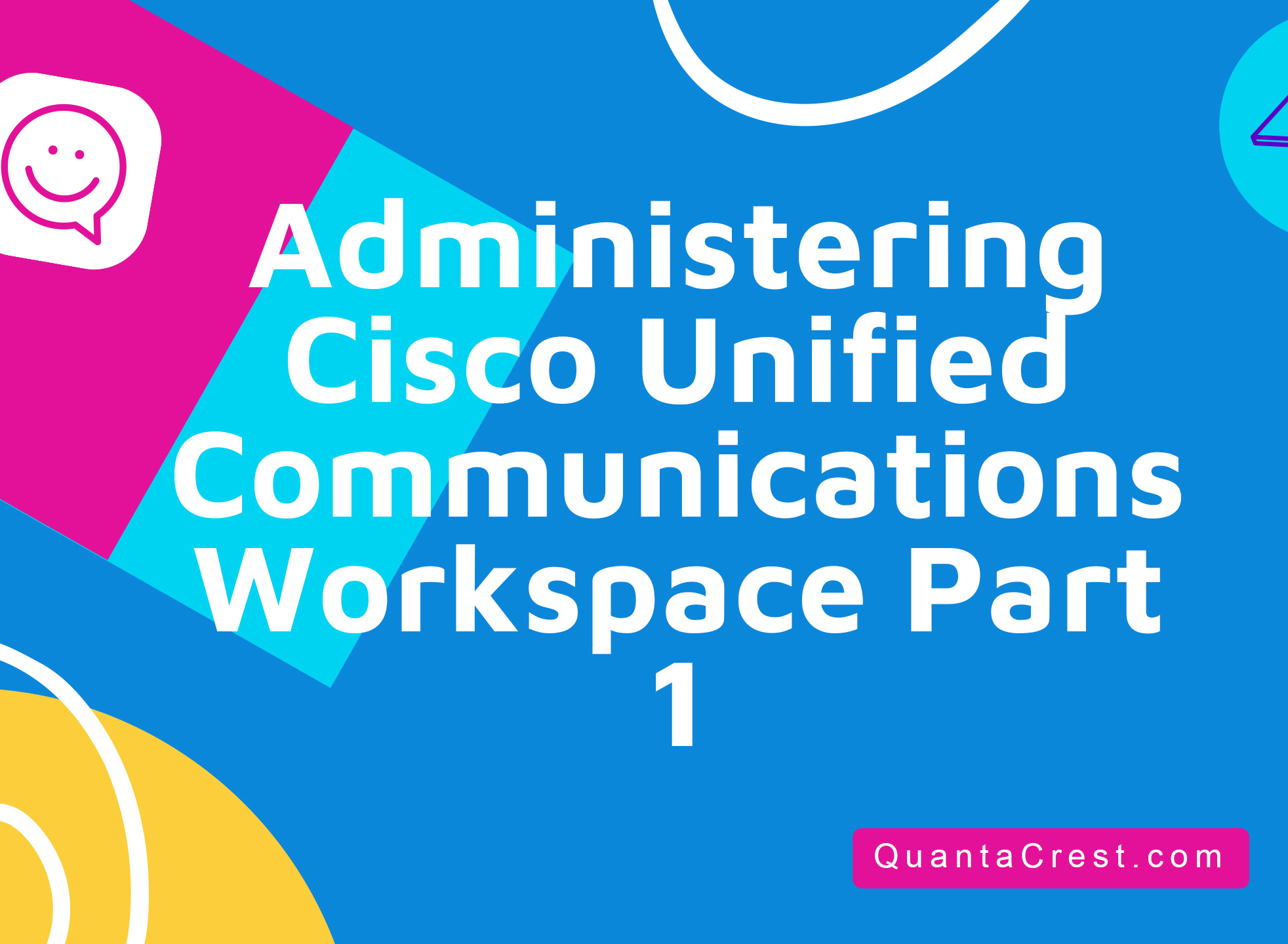Administering Cisco Unified Communications Workspace Part 1
in CiscoAbout this course
Course Overview
This exclusive course offers a unique real-world environment focusing on the administration of a Cisco IP telephony, video and voice mail solution, including: Cisco Unified Communications Manager (CUCM) v12.5: Unity Connection v12.5: Cisco IM&P v12.5.
You will learn how to access the CUCM administrative pages to perform moves, adds, and changes of Cisco IP phones, while configuring users and associating them with phones. You will learn to configure simple features, such as DND, Music on Hold, MeetMe conferencing, and shared lines and barge, as well as access to CUCM user web pages. Configuring voice mail accounts for users, building a Jabber Client, and managing licenses using Prime License Manager with Cisco Unified Communications Manager v12.5 are also incorporated in this course.
You will gain a basic understanding of the route patterns that are used for dialing and Class of Service, controlling who can dial where, such as internal, local, long distance, and so forth.
The lab environment features a fully configured cluster with Headquarters and PSTN sites. A complete dial plan, including Class of Service, is deployed using the most recent CUCM features supporting simpler dial plan configuration. Our Unified Communications (UC) courses provide a simulated PSTN, enabling you to gain an understanding of the North American Numbering Plan (NANP) and the concepts associated with a variable-length on-net dial plan supporting multiple sites with overlapping extensions. In this class, the dial plan is preconfigured and allows you to apply Class of Service to phones and lines and to test calling to 3-digit, 7-digit, 10-digit, 11-digit, and international route patterns.
Target Audience
Administrators who need to perform MACDs (Moves, Adds, Changes and Deletes). Administrators, engineers, network architects, and integrators with overall responsibility for Cisco UC networks requiring a better understanding of multisite administration.
Course Objectives
During this course you will learn:
- Understand basic CUCM architecture and terminology
- How the CUCM administrative and user GUIs work
- Get organized with Device Pools and other common elements of phone configuration
- Understand Internal dialing in a multi-site/multi-cluster deployment
- Manage Directory Numbers and DIDs in a multi-site/multi-cluster deployment, track assigned/unassigned and temporarily
- reserved DIDs and quickly find available DIDs at any site when adding new Users
- Work with shared lines and phantom numbers
- Add and delete phones manually, using auto registration and using the BAT tool
- Speed up Moves/Adds and Changes at each site with LDAP and templates
- Build and use site specific templates
- Make the most out of the BAT tool to make moves, adds, changes and deletes quicker and easier to manage
- Manage Meet me number ranges and Conference Now conferencing in a multi-site environment
- Add users, assign them capabilities, and associate them with phones
- Configure phones for Class of Service using the line/device approach
- Configure phones for voice mail
- Configure Cisco Unity Connection users
- Deploy and use the Cisco Jabber Client in Phone Only and Full UC modes
Course Content
Module 1: Introduction to Cisco Unified Communications
- Understanding Components of Cisco Unified Communications Solutions
- Understanding the Characteristics of Cisco Unified Communications Solutions
Module 2: Understanding User Interfaces
- Understanding Administrator Interfaces
- Understanding End-User Interfaces
Module 3: End User Configuration
- Understanding End-User Characteristics
- Understanding End-User Implementation
Module 4: Endpoint Configuration and Native Presence
- Understanding Endpoint Characteristics
- Understanding Endpoint Implementation
- Configuring Native Unified Communications Manager Native Presence
Module 5: Understanding Cisco Unified Communications Manager Dial Plans
- Understanding Call Flows and Call Legs
- Describing Dial Plan Components
- Endpoint Addressing and Call Routing Overview
- Implementing Class of Service
- Call Coverage
Module 6: Audio and Video Conferencing and Music on Hold
- Describing Media Resources
- Annunciators and MOH
- Implementing Conference Bridges
Module 7: Cisco Unity Connection Users, Mailboxes and Basic Call Management
- Understanding Cisco Unity Connection
- Integrating Cisco Unity Connection with Cisco Unified Communications Manager
- Configuring CUC Users, Templates and CoS
- Configuring the Cisco Unity Connection System
- Implementing Cisco Unity Connection Dial Plan and Call Management
- Configuring Unified Messaging
- Troubleshooting Cisco Unity Connection
Labs:
- Lab 1-Remote Lab Access
- Lab 2-Exploring Cisco Collaboration Administrator Interfaces Enhanced
- Lab 3-Exploring Cisco Collaboration OS Administration
- Lab 4-Exploring Cisco Collaboration End User Interfaces Enhanced
- Lab 5-User Management - Manual Administration Enhanced
- Lab 6-User Management - Bulk Administration Tool Enhanced
- Lab 7-User Management - LDAP Integration Enhanced
- Lab 8-MACDs-Managing the SEA253 Site NEW
- Lab 9-Implementing Endpoints using BAT
- Lab 10-IMP and Jabber Clients NEW
- Lab 11-Basic Cisco IP Phone Configuration: Basic Features
- Lab 12-MACDs - Managing the NYC516 Site OPTIONAL BONUS Lab NEW
- Lab 13-Exploring Call Flows in CUCM Enhanced
- Lab 14–Forwarding, Call-Park and Call-Pickup Enhanced
- Lab 15-Call Hunting Enhanced
- Lab 16-Music on Hold and Software Conference Resources Enhanced
- Lab 17-More Telephony Features OPTIONAL BONUS Lab
- Lab 18-Users and Mailboxes Enhanced
- Lab 19–Call Handling at the SEA253 Site New
Course Prerequisites
Attendees should meet the following prerequisites:
- Familiarity with relevant technologies and an understanding of router configuration is recommended but not required.
Test Certification
Recommended as preparation for the following exams:
- There is no exam currently aligned to this course
Follow on Courses
The following are recommended for further study:
- ACUCW2 - Administering Cisco Unified Communications Workspace Part 2
Comments (0)






